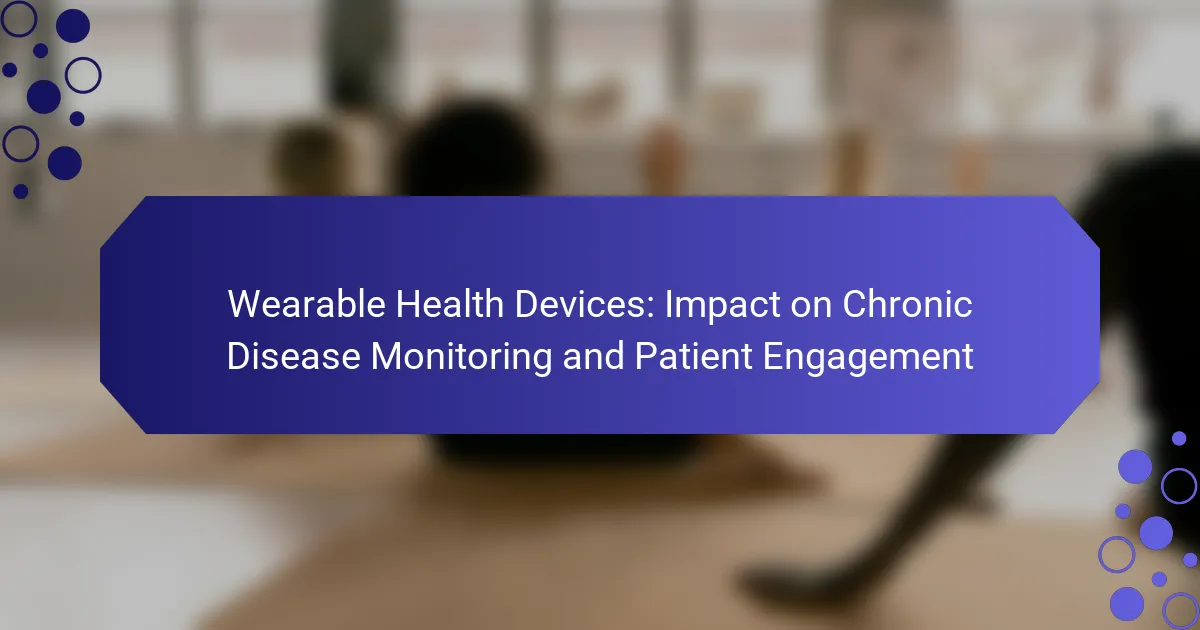Wearable health devices enhance chronic disease monitoring by providing real-time data and personalized insights. They improve patient engagement through actionable feedback and goal-setting. Despite challenges like data privacy and device accuracy, advancements in technology and regional adaptations are driving their effectiveness. Best practices can maximize their benefits for chronic disease management.
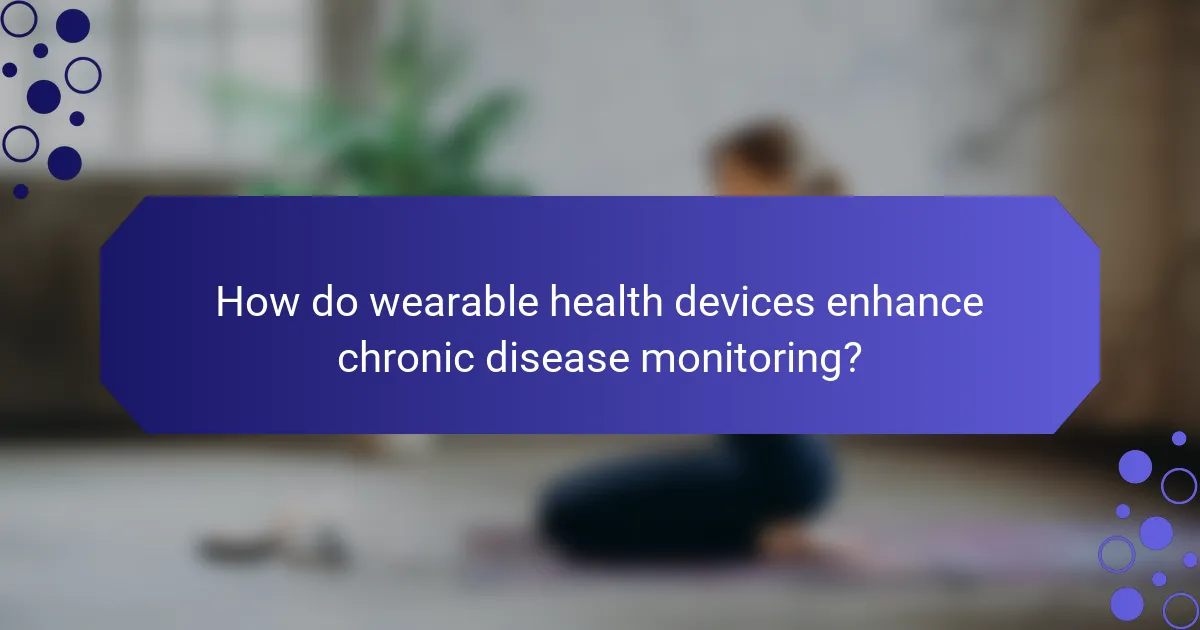
How do wearable health devices enhance chronic disease monitoring?
Wearable health devices significantly enhance chronic disease monitoring by providing real-time data and personalized insights. These devices track vital signs, medication adherence, and activity levels, enabling proactive management of conditions like diabetes and hypertension. As a result, patients experience improved engagement and better health outcomes. Studies show that consistent use of wearables can lead to a 30% reduction in hospital readmissions for chronic disease patients. This technology empowers individuals to take control of their health through actionable feedback and tailored interventions.
What key features enable effective monitoring of chronic conditions?
Wearable health devices enable effective monitoring of chronic conditions through real-time data tracking, personalized alerts, and remote health assessments. These features enhance patient engagement and facilitate timely interventions. Continuous heart rate monitoring, activity tracking, and sleep analysis are critical attributes that provide comprehensive insights into patient health. Integration with mobile applications allows for easy data sharing with healthcare providers, improving care coordination.
Which chronic diseases benefit most from wearable technology?
Wearable technology significantly benefits chronic diseases such as diabetes, heart disease, and asthma. These devices enable real-time monitoring of vital signs and symptoms, enhancing patient engagement and adherence to treatment plans. For instance, continuous glucose monitors assist diabetes patients in managing their blood sugar levels effectively. Similarly, heart rate monitors help individuals with cardiovascular issues maintain optimal heart health. Asthma management apps track triggers and medication usage, improving overall patient outcomes.
How do data accuracy and reliability impact patient outcomes?
Data accuracy and reliability significantly enhance patient outcomes by ensuring timely and informed healthcare decisions. Wearable health devices provide real-time data that can lead to proactive management of chronic diseases. Accurate data helps healthcare providers identify trends and adjust treatment plans effectively. Reliable information fosters patient engagement, encouraging individuals to take an active role in their health management. As a result, improved data quality correlates with better adherence to treatment protocols and ultimately enhances overall health outcomes.
What role does real-time data play in managing chronic diseases?
Real-time data significantly enhances chronic disease management by providing continuous monitoring and timely insights. Wearable health devices collect vital metrics, allowing for immediate adjustments in treatment plans. This data empowers patients to engage actively in their health, improving adherence to medication and lifestyle changes. For instance, heart rate variability data can indicate stress levels, prompting users to take preventive measures. As a result, real-time data fosters a proactive approach to managing chronic conditions, ultimately leading to better health outcomes.
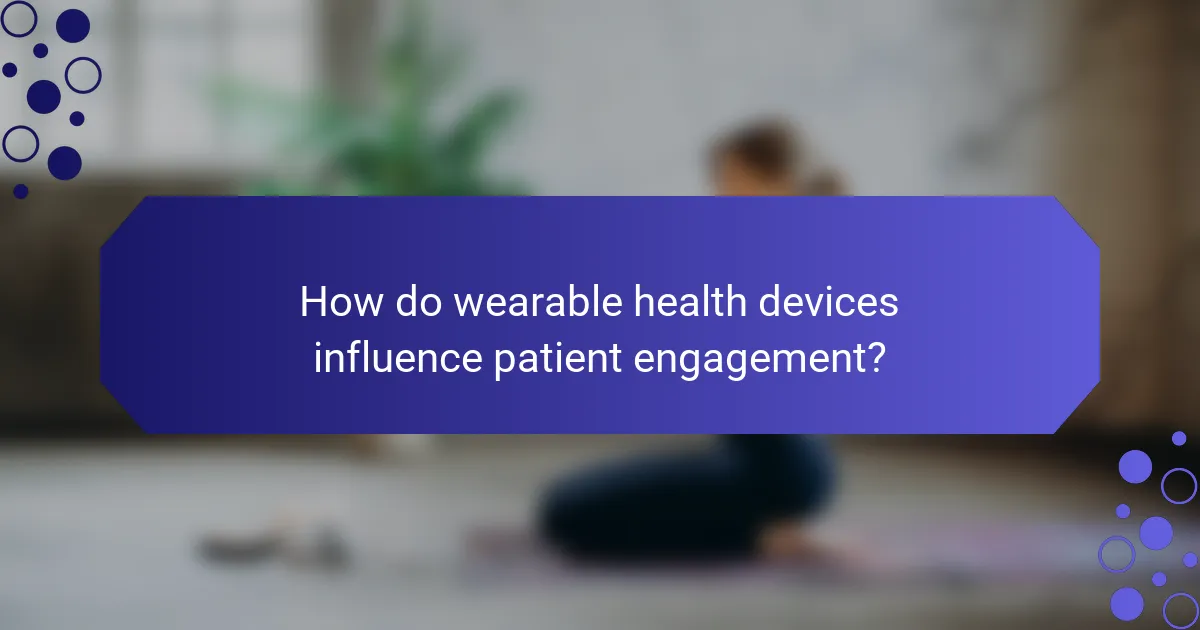
How do wearable health devices influence patient engagement?
Wearable health devices significantly enhance patient engagement by providing real-time data and personalized feedback. These devices empower patients to monitor their health metrics, fostering a proactive approach to chronic disease management. For instance, studies indicate that users of wearable technology report a 30% increase in adherence to treatment plans. Additionally, the ability to track progress encourages patients to set and achieve health goals, leading to improved outcomes. Engaging patients through these devices ultimately transforms their relationship with healthcare, making them active participants in their wellness journey.
What motivational factors drive user compliance with wearable devices?
User compliance with wearable devices is primarily driven by intrinsic motivation, social influences, and personalized feedback. Intrinsic motivation includes personal health goals, while social influences involve support from peers and family. Personalized feedback enhances user engagement by providing tailored insights and progress tracking. These factors contribute to greater adherence and effective chronic disease management.
How do wearable health devices facilitate communication between patients and healthcare providers?
Wearable health devices enhance communication by providing real-time data and facilitating remote monitoring. These devices enable seamless interaction between patients and healthcare providers, improving engagement and adherence to treatment plans. For example, continuous glucose monitors send data directly to healthcare teams, allowing for timely interventions. This proactive communication helps in managing chronic diseases more effectively.
Which features promote user-friendly experiences and sustained engagement?
User-friendly features in wearable health devices include intuitive interfaces, real-time data tracking, personalized notifications, and seamless integration with mobile applications. These elements enhance user engagement by providing immediate feedback and actionable insights. For instance, devices that offer customizable alerts can significantly improve adherence to health monitoring routines. Compatibility with other health platforms fosters a holistic view of patient health, encouraging sustained interaction.
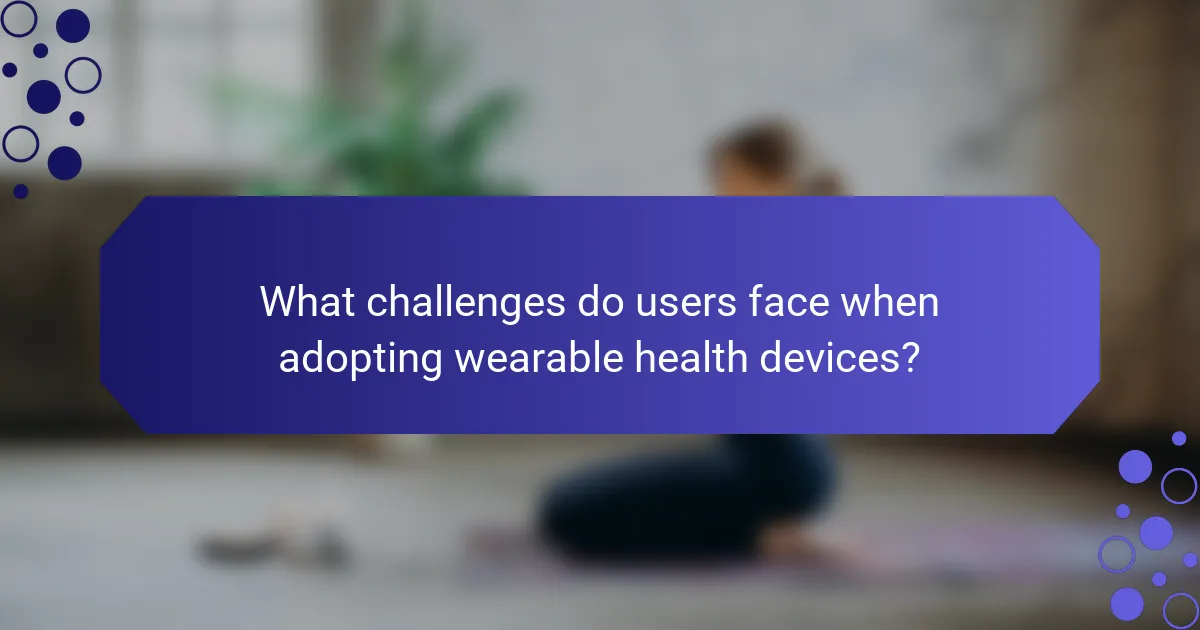
What challenges do users face when adopting wearable health devices?
Users face several challenges when adopting wearable health devices, including data privacy concerns, device accuracy, and user engagement. Many users worry about how their health data is collected and shared, which can hinder adoption. Accuracy is vital; inaccurate readings can lead to mistrust and decreased usage. Additionally, maintaining consistent engagement with the device is often difficult, as users may find it cumbersome or forget to wear it regularly. These factors can significantly impact the effectiveness of wearable health devices in chronic disease monitoring and patient engagement.
How do privacy concerns affect user trust and device usage?
Privacy concerns significantly undermine user trust in wearable health devices, which impacts their usage. Users are hesitant to share sensitive health data due to fears of data breaches and misuse. A study revealed that 60% of potential users are deterred by privacy worries. This skepticism can lead to lower engagement and reduced effectiveness in chronic disease monitoring. Ensuring robust data protection measures and transparent privacy policies can enhance user confidence and promote device adoption.
What are the common technical issues reported by users?
Common technical issues reported by users of wearable health devices include connectivity problems, inaccurate data readings, battery life concerns, software glitches, and difficulties with syncing data. These issues can hinder effective chronic disease monitoring and patient engagement.
Connectivity problems often arise due to Bluetooth interference or app compatibility. Inaccurate data readings can occur from sensor malfunctions or improper device placement. Battery life concerns typically relate to frequent recharging needs, impacting usability. Software glitches may lead to crashes or slow performance, while difficulties with syncing data can disrupt the flow of health information.
How can healthcare professionals address user resistance to technology?
Healthcare professionals can address user resistance to technology by emphasizing education and support. Providing clear information about wearable health devices’ benefits, such as improved chronic disease monitoring and enhanced patient engagement, can alleviate concerns. Demonstrating ease of use and offering personalized training can further reduce resistance. Regular follow-ups and feedback opportunities can foster trust and encourage adoption.
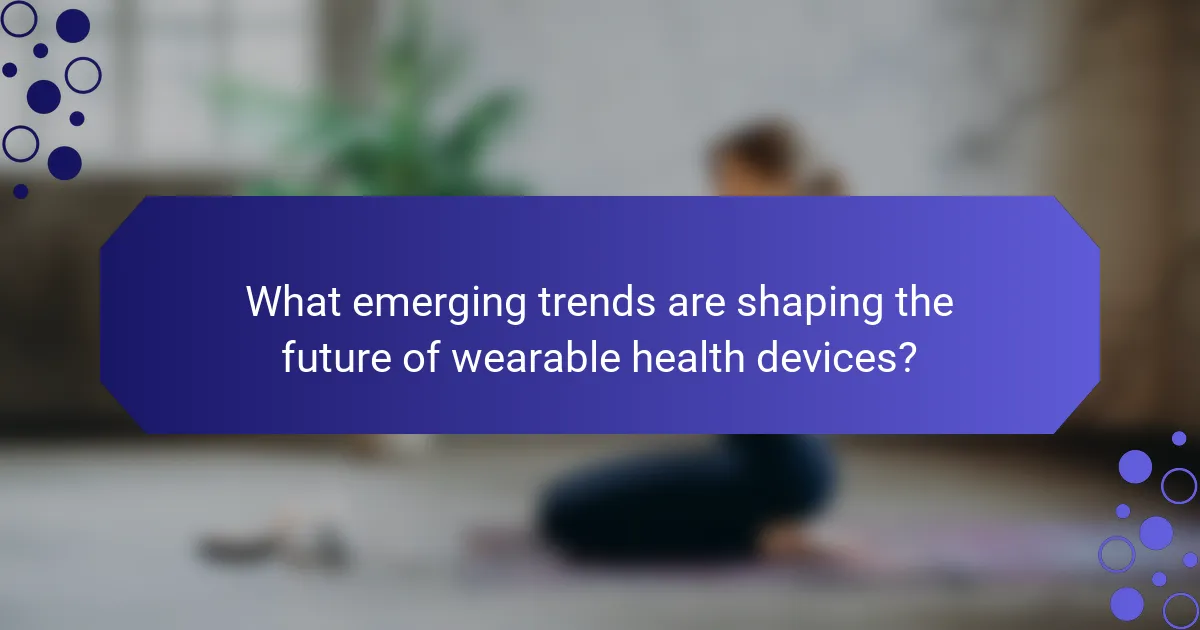
What emerging trends are shaping the future of wearable health devices?
Wearable health devices are increasingly leveraging advanced technologies to enhance chronic disease monitoring and patient engagement. Emerging trends include the integration of artificial intelligence for personalized health insights, real-time data sharing with healthcare providers, and enhanced user interfaces for improved patient interaction.
These devices now often feature advanced sensors capable of tracking multiple health metrics, such as blood glucose levels and heart rate variability. As a result, they empower patients with actionable insights, fostering proactive health management.
Moreover, the rise of telehealth solutions is driving greater adoption of wearables, allowing for continuous monitoring and timely interventions. This trend is crucial for managing chronic diseases effectively, as it facilitates better communication between patients and healthcare professionals.
In addition, gamification elements are being incorporated to increase user engagement and adherence to health plans. By making health management more interactive, these devices can motivate users to maintain healthier lifestyles.
How is artificial intelligence enhancing wearable health devices?
Artificial intelligence significantly enhances wearable health devices by improving chronic disease monitoring and patient engagement. AI algorithms analyze real-time data, enabling timely interventions and personalized health insights. For example, machine learning models can predict potential health issues based on historical data, allowing for proactive management of conditions like diabetes or heart disease. This integration fosters better patient adherence to treatment plans, ultimately leading to improved health outcomes. Additionally, AI-driven analytics can enhance user experience by providing tailored feedback and recommendations, increasing overall engagement with the device.
What advancements in sensor technology are expected in the coming years?
Advancements in sensor technology will enhance wearable health devices, improving chronic disease monitoring and patient engagement. Innovations like miniaturized biosensors and advanced data analytics will enable real-time health tracking. These devices will increasingly utilize artificial intelligence for personalized insights, facilitating proactive health management. Enhanced connectivity features will also promote seamless data sharing between patients and healthcare providers, fostering better communication and engagement.
Which regulatory changes could impact the development of wearable health devices?
Regulatory changes could significantly impact the development of wearable health devices by influencing design, functionality, and data privacy. New regulations may enforce stricter data protection standards, affecting how manufacturers collect and store user health information. Additionally, guidelines on device efficacy and safety could require more rigorous testing before market entry, potentially delaying product launches. These changes aim to enhance patient safety and trust in wearable technology while promoting innovation in chronic disease monitoring.
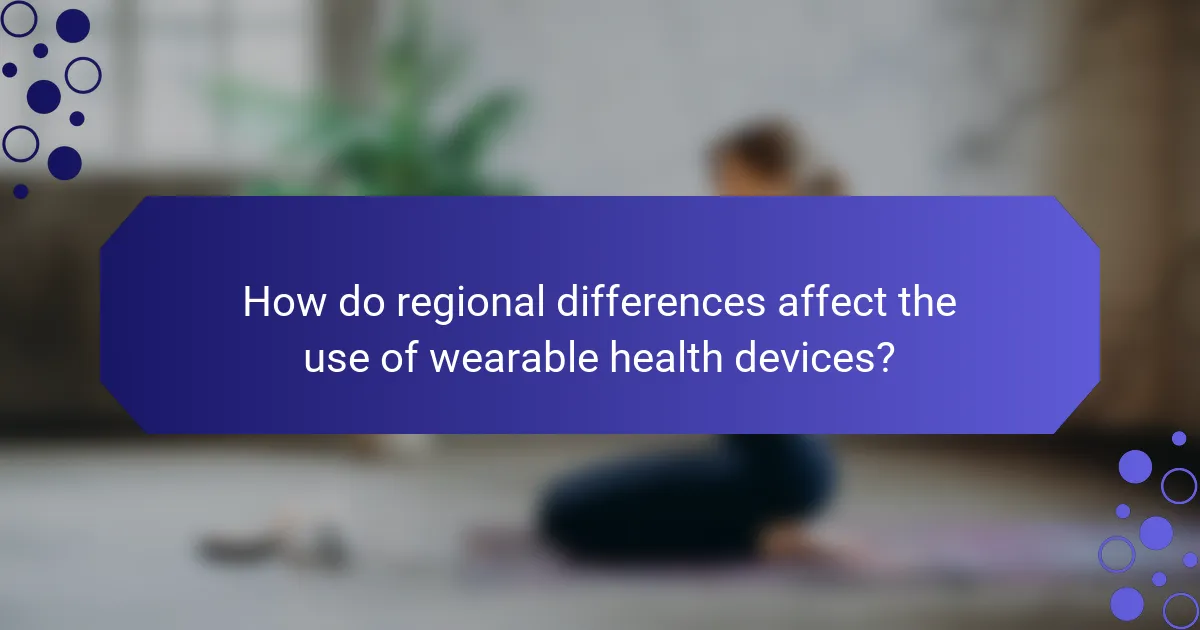
How do regional differences affect the use of wearable health devices?
Regional differences significantly influence the adoption and effectiveness of wearable health devices. Variations in healthcare infrastructure, cultural attitudes towards technology, and socioeconomic factors shape how these devices are used for chronic disease monitoring and patient engagement.
In regions with advanced healthcare systems, wearables are integrated into routine care, enhancing patient data tracking and real-time monitoring. Conversely, in areas with limited access to healthcare, wearables may serve as standalone tools, primarily for self-monitoring.
Cultural perceptions also play a role. In some cultures, there is a strong emphasis on traditional medicine, which may hinder the acceptance of technology-based solutions. Additionally, socioeconomic factors affect affordability and accessibility, impacting the widespread use of wearables.
Ultimately, understanding these regional differences is crucial for tailoring wearable health devices to meet diverse patient needs effectively.
What cultural attitudes influence the adoption of wearable technology in healthcare?
Cultural attitudes significantly affect the adoption of wearable technology in healthcare. Factors such as trust in technology, health literacy, and perceptions of privacy shape user acceptance.
In cultures with high technological trust, individuals are more likely to embrace wearable devices for chronic disease management. Conversely, skepticism about technology can hinder adoption. Health literacy also plays a critical role; those with better understanding of health issues are more inclined to use wearables effectively.
Privacy concerns can vary culturally, influencing users’ willingness to share personal health data. In some societies, there is a strong emphasis on data security, leading to hesitance in adopting these technologies. As a result, addressing these cultural nuances is essential for successful implementation of wearable health devices.
How do different healthcare systems integrate wearable devices into patient care?
Healthcare systems integrate wearable devices into patient care through real-time monitoring, personalized feedback, and enhanced patient engagement. These devices enable continuous health tracking, allowing providers to adjust treatment plans based on data. For example, remote patient monitoring of chronic conditions like diabetes improves adherence to care protocols. Integration varies by system; some utilize advanced data analytics, while others focus on basic notifications. Overall, wearables enhance communication between patients and healthcare professionals, fostering proactive health management.
What are the most popular wearable health devices in various regions?
Wearable health devices are increasingly popular across various regions, with notable trends in North America, Europe, and Asia. In North America, fitness trackers dominate, emphasizing activity monitoring. Europe shows a mix of smartwatches and medical-grade devices focused on chronic disease management. In Asia, the market is expanding rapidly, with a growing interest in health monitoring features integrated into smartphones and wearables. Each region’s preferences reflect local health priorities and technological adoption rates.
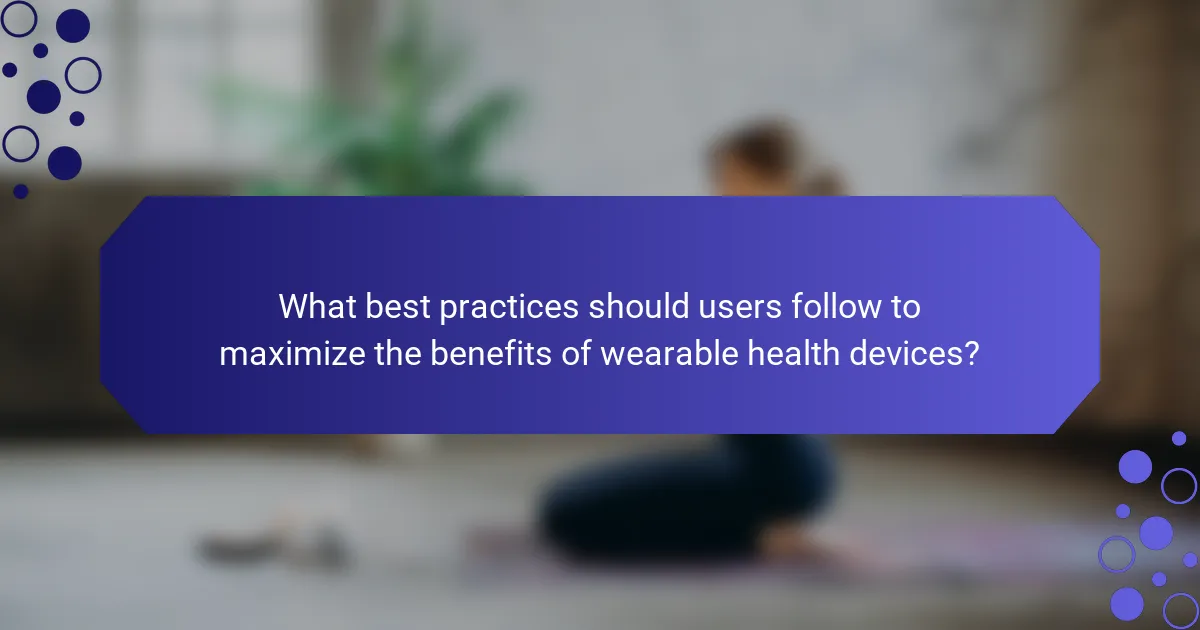
What best practices should users follow to maximize the benefits of wearable health devices?
To maximize the benefits of wearable health devices, users should follow these best practices. Regularly sync the device with health apps to track data accurately. Set specific health goals to enhance motivation and engagement. Utilize reminders for medication and activity to maintain consistency. Share data with healthcare providers to foster informed discussions about chronic disease management. Finally, stay updated on software and firmware updates to ensure optimal device performance.
How can users effectively interpret and utilize data from their devices?
Users can effectively interpret and utilize data from their wearable health devices by focusing on clear metrics and actionable insights. Regularly reviewing metrics like heart rate, activity levels, and sleep patterns helps identify trends. Engaging with personalized feedback from the device fosters better health decisions. For example, setting achievable goals based on tracked data encourages sustained activity. Users should also integrate this data with healthcare provider consultations to enhance chronic disease management. This collaboration can lead to tailored treatment plans, improving overall patient engagement and health outcomes.
What strategies can enhance the integration of wearable technology into daily routines?
Integrating wearable technology into daily routines can be enhanced through personalized health goals, seamless app connectivity, and regular user feedback. Personalized health goals align device capabilities with individual needs, fostering engagement. Seamless app connectivity ensures data flows smoothly between devices and health platforms, enhancing usability. Regular user feedback allows for adjustments to routines, improving adherence and health outcomes.
How can patients collaborate with healthcare providers to optimize device usage?
Patients can collaborate with healthcare providers by actively engaging in their health management. Effective communication about device usage enhances monitoring and supports chronic disease management.
Regularly sharing data from wearable health devices allows providers to adjust treatment plans. Patients should familiarize themselves with device features and functionalities to maximize benefits.
Establishing a routine for data review during appointments fosters accountability. Providers can guide patients on interpreting device data, ensuring informed decisions about their health.
Encouraging feedback about device performance helps improve patient experience and device functionality. This partnership ultimately leads to better health outcomes and increased patient satisfaction.
